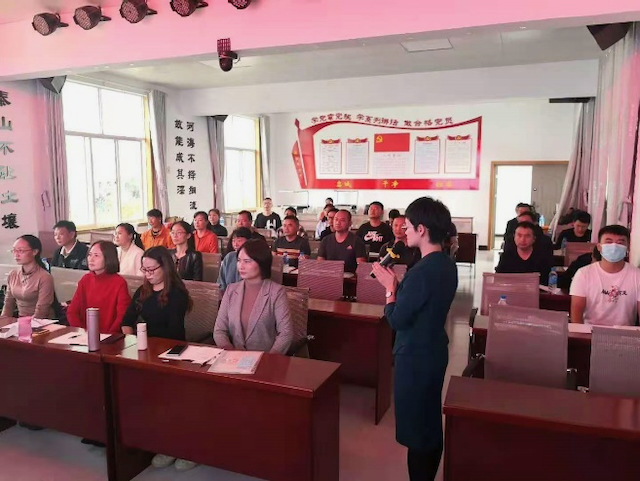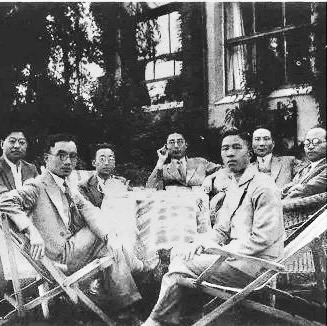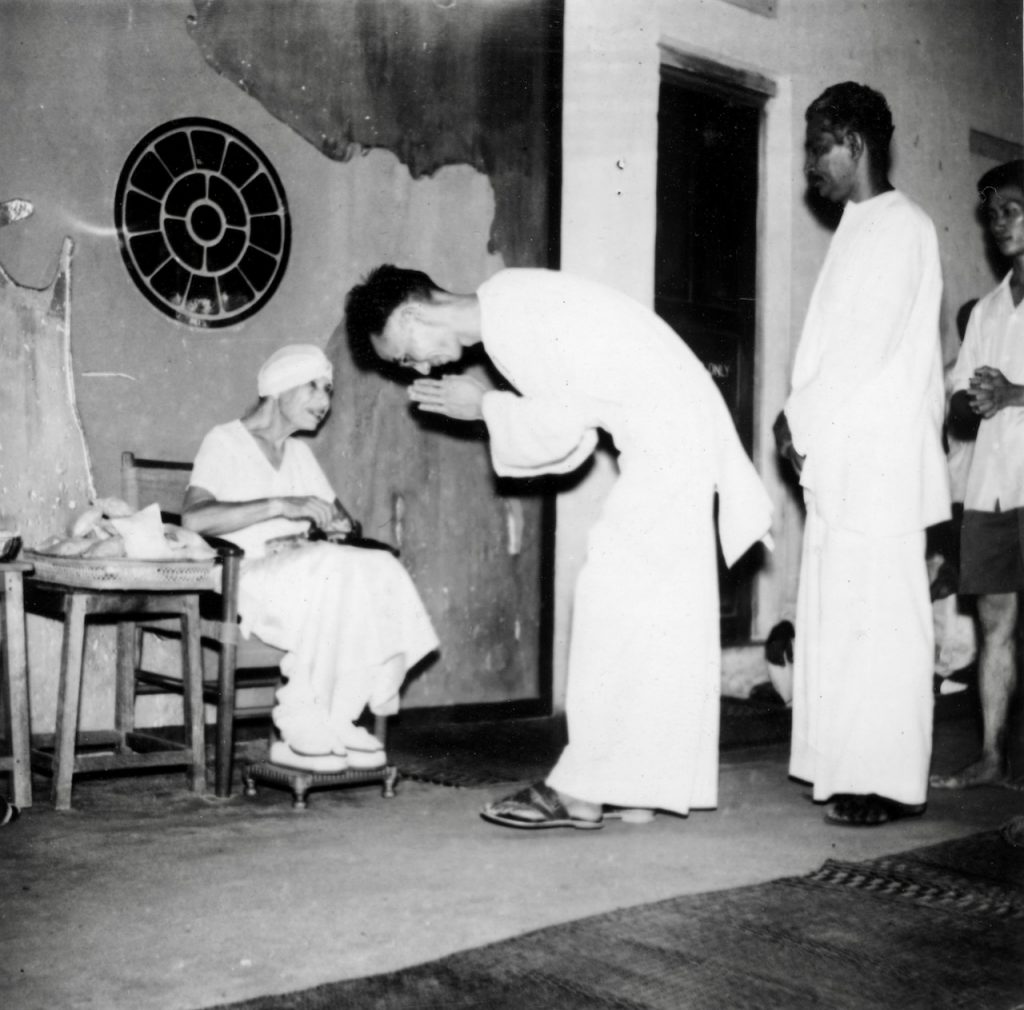(26 October 1909, Changsha – 6 March 2000, Beijing)
A Poet, Chinese painter, calligrapher, and translator. A scholar who, during the 20th century, studied German, Chinese, and Indian civilizations and made significant contributions in these three cultural spheres.
Prof. Xu Fancheng (徐梵澄 ) was one of the greatest Chinese-Sanskrit scholars in the contemporary history of cultural and philosophical interactions between India and China. He was the first Chinese scholar to translate the Complete Works of Sri Aurobindo into Chinese.
EARLY LIFE
Prof. XuFancheng studied and taught the Philosophy of Ouyang Jingwu 歐陽竟無 at Shantiniketan. After 3 years he moved to Varanasi and continued his study on Sanskrit literature.
(The Philosophy of Ouyang Jingwu is the combination of pure Buddhism from India and Confucianism from China with original consciousness theory as the focus).
From 1929 to 1932 He studied Fine Art and Philosophy at the University of Königsberg, Germany. His study at Königsberg was inspired by Lu Xun’s advice.
From 1937 to 1938, he taught at Tongji University. From 1939 to 1940 he taught at the National Academy of Arts.
From 1941 to 1945, he served as the editor of the Central Library, presided over the “Book Monthly”, and served as a professor at the Central University.
XuFancheng & LuXun
Xu Fancheng (1895-1977) and Lu Xun (1881-1936) were both influential Chinese writers and intellectuals who lived during the early 20th century. Xu Fancheng was a translator and scholar who focused on ancient Indian texts and philosophy, while Lu Xun was a writer and literary critic known for his short stories, essays, and novels that explored social and political issues in China. They knew each other or were aware of each other’s work, as they were both active in intellectual circles in China during the same time period.
On May 15, 1928, Prof. Xu attended Lu Xun ‘s speech at Fudan Middle School, he met and corresponded with Lu Xun, and started writing for ” Yusi ” , the first literary journal mainly based on prose in the history of modern Chinese literature .
From 1929 to 1932 He studied Fine Art and Philosophy at the University of Königsberg, Germany. His study at Königsberg was inspired by Lu Xun’s advice.
1929 to 1932 – During his stay at Germany , he used to send wood block prints to LuXun.
His study at Königsberg was inspired on Lu Xun’s advice. LuXun’s diary mentions about Prof. Xu (as Fancheng and Shiquan) many times during this period.
“Mr LuXun has always been fond of art, and he is always concerned about art books, and he likes to buy and browse. Mr Xu Shiquan (Prof.XuFancheng), who studied in Germany, and Mr Ji Zhiren, who studied in France, asked them to search for printmaking.” Xu is because of his special era and strong love for printmaking, which made Lu Xun choose to introduce and support the art of printmaking.
Xu Shiquan ,(Xu Fancheng) was a central figure in LuXun’s development as an authority on art and more broadly in the understanding of European arts and artists.
Prof. Xu Fancheng was assisted by Lu Xun to translate Nietzsche’s Ecce Homo, Thus Spoke Zarathustra, Daybreak, and The Gay Science into Chinese in the last years of Lu Xun’s life. Lu Xun contributed to Xu’s project mainly by pointing him to the volumes that need to be translated and helping him with the publication process.
Nietzsche’s Thus Spoke Zarathustra translated by Prof. XuFancheng published in 1941, printed in China
XuFancheng’s collected works, show that he was not only a translator of Indian philosophical works. He was also an original writer, and even though most of his own creations are relatively short, they cover an extensive range, reflecting deeply on Confucianism, Taoism and Buddhism, as well as classical Grecian philosophy. The translation of the Upanishads has been reprinted twice, (editor Huang Yansheng, of the Chinese Social Sciences Publishing).
PROF XU LIFE IN INDIA
Prof. Xu Fancheng came to India in 1945, under the India-China cultural exchange program, and joined the Chinese Institute (Cheena Bhavan) of Viswa Bharati university, Shantiniketan. Prof. XuFancheng taught the Philosophy of Ouyang Jingwu 歐陽竟無 at Shantiniketan. After 3 years he moved to Varanasi and continued his study on Sanskrit literature.
Prof. XuFancheng came to Pondicherry in 1951, he became a devotee of Sri Aurobindo and a follower of The Mother. For 27 years (1951 -78) he lived at Pondicherry and devoted himself in translating the works of Sri Aurobindo under the guidance of The Mother. Prof. XuFancheng translated most of the significant works of Sri Aurobindo and The Mother to Chinese which included The Life divine(1984), On Yoga (1988), Integral Yoga (2OO5), and Yoga Letter set (2005).
In 1957 at Pondicherry, Prof. XuFancheng published Kalidasa’s original Sanskrit work Meghaduta and “The Bhagavad Gita” in the traditional Chinese language. In his works, Prof. XuFancheng adopted an original style of Lisao and Chinese poetry by composing his own poems on the basis of the original meaning. The original handwritten Bhagavad Gita manuscript can be found at Shanghai Museum.
In 2006 — the year of India China friendship Year. Prof. XuFancheng’s works were published in 16 volumes by the Shanghai Joint Publishing Company in 2006. Today in the field of India-China relations he is regarded as the greatest cultural bridge between India and China and regarded as the modern-day XuanZang.
(The Philosophy of Ouyang Jingwu is the combination of pure Buddhism from India and Confucianism from China with original consciousness theory as the focus).
The Mother On Hsu Hu ( XuFancheng)
The Mothers Agenda-Volume-03 -October 30-1962
My translation [of The Synthesis of Yoga] will be finished soon – I’ll miss it. But aren’t you going to start on Savitri?
It suddenly seemed terribly ambitious to me…. (Laughing) My stock of words isn’t so great! (silence) H.S(HuHsu) has written to me, and there was a sentence in his letter that brought a certain problem to my attention. He said, “I have done so many hours of translation – it’s a mechanical task.” I wondered what he meant by “mechanical task” because, as far as I am concerned, you can’t translate unless you have the experience – if you start translating word for word, it no longer means anything at all. Unless you have the experience of what you translate, you can’t translate it. Then I suddenly realized that the Chinese can’t translate the way we do! In Chinese, each character represents an idea rather than a separate word; the basis is ideas, not words and their meanings, so translation must be a completely different kind of work for them. So I started identifying with H.S., to understand how he is translating Sri Aurobindo’s Synthesis of Yoga into Chinese characters – he’s had to find new characters! It was very interesting. He must have invented characters. Chinese characters are made up of root-signs, and the meaning changes according to the positions of the root-signs. Each root-sign can be simplified, depending on where it’s placed in combination with other root-signs – at the top of the character, at the bottom, or to one side or the other. And so, finding the right combination for new ideas must be a fascinating task! (I don’t know how many root-signs can be put in one character, but some characters are quite large and must contain a lot of them; as a matter of fact, I have been shown characters expressing new scientific discoveries, and they were very big.) But how interesting it must be to work with new ideas that way! And H.S. calls it a “mechanical task.” The man’s a genius! And he has experiences, too. We’ve hardly ever spoken together, but I have seen some letters he wrote. To one person he said, “If you want the Taoist experience, all you have to do is come here and live at the Ashram – you will have the realisation of Lao-Tse’s philosophy.”
The Mother wrote thus about him “… A Scholar who is at once an artist and a yogi.”
“To understand how he (XuFancheng) is translating Sri Aurobindo’s Synthesis of Yoga into Chinese characters—he’s had to find new characters! It was very interesting. It was very interesting.
Auroville charter handwritten by Prof. XuFancheng
In an article in Nan Yang Siang Pau, a newspaper in Singapore, Hu Hsu introduced the project of Auroville in Chinese and spoke about building “…a Pavilion which can represent the culture and arts achievements of the great Chinese civilisation”, and invited Chinese scholars and artists to participate.
Soon after Mother left her body on 17 November 1973, Prof. Hsu also left Pondicherry in 1978.
EXTERNAL RESOURCES :







